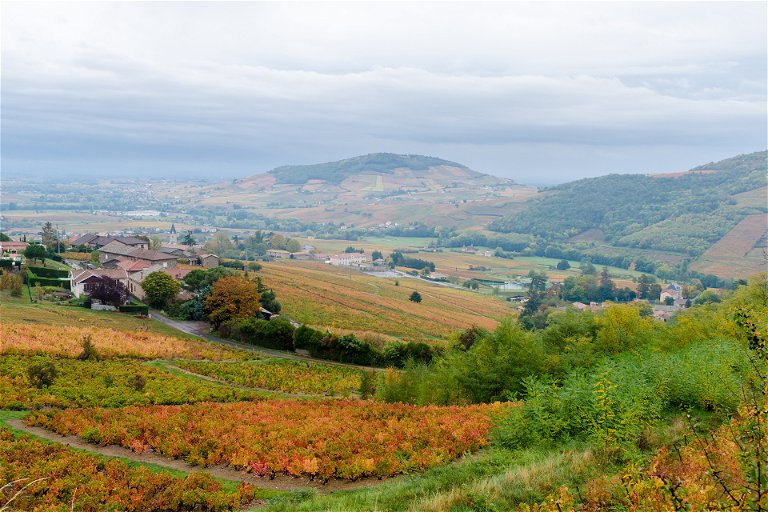Beyond the Nouveau: exploring the subtle complexities of Beaujolais’ 10 crus
Closing the door on the Nouveau festivities, Falstaff turns to the richer delights of Beaujolais’ more grown-up wines: its top-notch crus.
Every year on the third Thursday in November, at precisely 12.01 am, the French region of Beaujolais erupts with the celebrations of the first young wine of the season. The rest of the country, and much of the wine world, joins them in the frivolity of Beaujolais Nouveau Day. It’s so firmly ensconced in the vinous imagination that it’s easy to forget the serious wines made just a stone’s throw from the Nouveau heartlands. Ignore these wines at your peril: they can be exquisite and surprisingly age-worthy. Good news for those of us long ago priced out of Burgundy.
The Beaujolais region is, in fact, often included in the greater Burgundy area with, somewhat contentiously, a number of its communes releasing wine under the Bourgogne AOC. However, almost all of Beaujolais falls outside Burgundy’s administrative region of Bourgogne-Franche-Comté, lying, in fact, in the neighbouring Rhône département. Don’t be fooled into thinking of Beaujolais as a Rhône wine however – only the very northern tip of the Rhône’s famous winelands (Côte-Rôtie and Condrieu, to be precise) actually shares the modern département of the Rhône.
This somewhat confusing arrangement, where geography, wine law and regional identity don’t quite align, has arguably left Beaujolais’ quality wines without such a clearly marketable identity as its big neighbours. A matter not helped by the Nouveau phenomenon. In terms of character and potential, however, Beaujolais is a region all its own – and its crus every bit as capable of producing uniqueness.

A patchwork of micro-terroirs
Cru Beaujolais stands at the summit of the area’s 3 quality classifications, beyond the generic Beaujolais AOC and the more highly regarded Beaujolais Villages. The 10 crus cluster to the north of the region, the most northerly of them (Saint-Amour) cheek by jowl with the Mâconnais. And yes, that’s most definitely in Burgundy. The area shares with its illustrious neighbour a continental climate: warm summers and cold, occasionally freezing winters. Although Beaujolais is marginally warmer – the influence of the Mediterranean can just be felt – it is subject to spring frosts and the baleful Mistral, so vineyards never stray too far from the Saône river that acts to temper such hostile forces.
It’s the granitic bedrock overlaid with light, free-draining soils that really helps the north produce ripe, intense, age-worthy wines. By contrast, the cooler clay of the flat plains to the south (home to much Nouveau production) makes for lighter, earlier-drinking styles. There are over 300 specific soil types, according to a decade-long survey by Inter Beaujolais, the region’s wine council. Such diversity means that each sub-area can produce wines of markedly different temperament, tannin and acidity levels. Using a single grape variety highlights differences between individual vineyards and producers even further.
Gamay comes into its own
Gamay, or Gamay Noir à Jus Blanc to give it its full title, reigns supreme here. It accounts for around 98 per cent of plantings. The tiny amount of Chardonnay that hops over from the Mâconnais is of no great concern to Beaujolais’ exclusively red crus. Despite the gallons of easy-drinking Beaujolais Nouveau made, Gamay doesn’t bestow its bounties easily. It’s a cousin of notoriously grumpy Pinot Noir, similarly early budding and early ripening. The latter is an asset with limited sunshine, but the former is a liability when early frosts threaten. It’s a vigorous variety as well and difficult to tame into wines of true distinction. To dampen its ardour, the vines are typically pruned into low bushes or “gobelets”. This, plus the steep topography of a number of the cru vineyards, makes hand harvesting almost inevitable, resulting in additional labour and cost.
The signature aromas achieved fall into three broad categories: red fruits, floral tones and a pleasing earthiness. At its best, this mix can be hugely appealing, displaying an elegance that is nonetheless warm and enveloping. Wines from the 10 crus tend to be fuller-bodied than their regional sisters, with occasional hints of black pepper and subtle spicing underpinning their more nuanced fruit. More present tannins give them significant ageing potential and structure on the palate; beautiful in the glass, they are lucent ruby shot with Tyrian purple.

Organic and low-intervention wines
Sustainable agriculture and low-intervention winemaking are key: in 2020, there were more than 150 Beaujolais wineries certified organic or in the process of conversion, and over 200 with High Environmental Value (HVE) certification. There are also several Demeter-certified winemakers working biodynamically. Jules Chauvet, a pioneer of France’s natural wine movement, was born here. Championing the use of quality fruit, ambient yeasts and reduced sulphur dioxide, he mentored local Morgon winemaker Marcel Lapierre who, along with Guy Breton, Jean Foillard, and Jean-Paul Thévenet, became known as the “Gang of Four”. They produce exceptional cru wines and have inspired a new generation to make careful, complex wines with an eye to sustainability.
Whilst Beaujolais has become synonymous with carbonic and semi-carbonic maceration; the crus often favours the more traditional barrel maturation associated with quality production in Burgundy and the Rhône. Wines can even see a small percentage of new oak. Gamay, handled this way, has the best chance of achieving its full promise.
Individuality and ageing potential
The list of crus makes a wonderful, sonorous litany. From north to south:
- Saint-Amour
- Juliénas
- Chénas
- Moulin-à-Vent
- Fleurie
- Chiroubles
- Morgon
- Régnié
- Brouilly
- Côte de Brouilly
These are the names to look out for on labels. Don’t expect to find the word Beaujolais, at least not obviously: these wines define themselves as expressions of place and in opposition to the idea of generic regional wine. Each cru has a distinct personality – there is much fun to be had tasting your way along the banks of the Saône, now a refreshing glass from the high-altitude Chiroubles, now a fuller-bodied offering from the slopes of Mont Brouilly, the landmark that lends its name to the two most southerly and hence warmest of the crus. Juliénas is one of the largest of the 10. Whilst its wines can age, its charms are immediate: richly coloured and juicy. Régnié is the baby of the bunch. Officially recognised only in 1988, it offers excellent value. Chénas has the smallest area under vine and is less commonly found. It bears seeking out, however, and requires time to achieve its best.

The most well-known of the crus cluster at the heart of the region. Moulin-à-Vent, named after a local windmill (image on top), is perhaps the most revered of all, producing wines of tannic depth that develop into dried plum, cherry, and a deep mushroomy loam. It has individual plots of great acclaim, including Les Clos, its oldest estate, and Les Thorin. Fleurie, as the name suggests, is fragrant with rose and violet but also peach beneath its carmine fruit. It can develop with age to display a surprising backbone and tantalising sweet spices. Morgon’s aromas are rich and uncompromising, with intense confit cherry riding smooth tannins. They develop to a truffled, forest floor quality, that is, forgive the heresy, reminiscent of Pinot Noir. Richest of all are the wines of its famous Côte du Py, a volcanic slope planted with ancient vines that really bring out the depth and warmth of which Gamay is capable.

